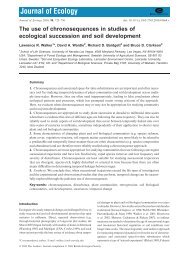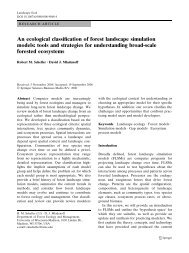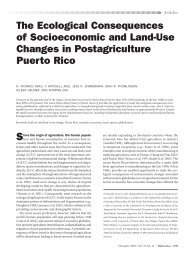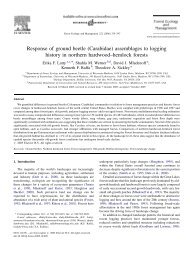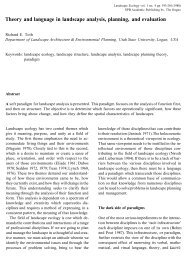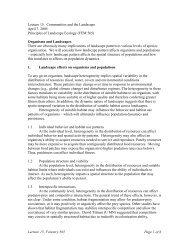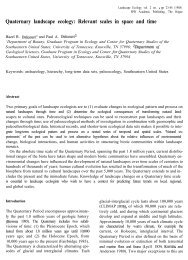Improving the formulation of tree growth and succession in a ...
Improving the formulation of tree growth and succession in a ...
Improving the formulation of tree growth and succession in a ...
Create successful ePaper yourself
Turn your PDF publications into a flip-book with our unique Google optimized e-Paper software.
Table 3<br />
Species life-history parameters<br />
Species<br />
r s<br />
(year −1 )<br />
K s<br />
(t)<br />
maxAge s<br />
(year)<br />
matu s<br />
(year)<br />
ED s<br />
(m)<br />
MD s<br />
(m)<br />
vegP s<br />
(−)<br />
sp ag s<br />
(year)<br />
E/D s<br />
(−)<br />
folType s<br />
(−)<br />
shdTol s<br />
(−)<br />
m<strong>in</strong>DD s<br />
(d)<br />
Abies alba 0.04 17.6 700 70 50 160 0 0 1 5 5 641 −6 3 3<br />
Larix deciduas 0.07 13.5 850 30 60 200 0 0 2 2 1 323 −11 3 2<br />
Picea abies 0.08 15.2 700 50 70 250 0 0 1 5 3 385 −11 2 2<br />
P<strong>in</strong>us cembra 0.03 5.9 1050 70 30 −1 0 0 1 5 3 323 −99 4 3<br />
P<strong>in</strong>us mugo 0.06 0.4 300 10 90 300 0 0 1 4 1 323 −99 5 2<br />
P<strong>in</strong>us silvestris 0.075 8.1 760 30 90 300 0 0 1 4 1 610 −99 5 2<br />
Alnus <strong>in</strong>cana 0.12 4.9 150 20 30 100 1 30 2 2 2 610 −99 1 2<br />
Alnus viridis 0.09 0.035 100 20 30 100 1 30 2 2 2 272 −99 2 2<br />
Betula pubescens 0.12 1.7 170 20 200 700 1 30 2 1 1 498 −99 3 1<br />
Populus nigra 0.12 10.6 280 20 240 800 1 30 2 2 3 662 −99 1 3<br />
Populus tremula 0.12 3.8 140 20 240 800 1 30 2 2 2 610 −99 3 3<br />
Salix caprea 0.12 0.4 170 20 430 1400 1 30 2 1 3 610 −99 2 1<br />
Sorbus aucuparia 0.12 1.8 110 10 30 −1 1 50 2 1 2 498 −99 4 2<br />
r: maximum above-ground biomass <strong>growth</strong> rate (Flury, 1895; Burger, 1945, 1947, 1948, 1950a,b, 1951, 1952, 1953; Anonymous, 1983; Schober, 1987; Lick <strong>and</strong> Sterba, 1991;<br />
Hillebr<strong>and</strong>, 1997); K: maximum aboveground <strong>tree</strong> biomass a species can potentially reach (Assmann, 1961; Grosser, 1977; Burger, 1945, 1947, 1948, 1950a,b, 1951, 1952, 1953;<br />
Bugmann, 1994); maxAge: expected longevity (Bugmann, 1994); matu: maturity age for seed production (Rohmeder, 1972, p. 35); ED: effective seed<strong>in</strong>g distance (m); MD: maximum<br />
seed<strong>in</strong>g distance (m) (Rohmeder, 1972); vegP: probability <strong>of</strong> vegetative reproduction, <strong>and</strong> spAge: maximum age for vegetative reproduction (Burschel <strong>and</strong> Huss, 1997); E/D: 1,<br />
denotes evergreen species; 2, deciduous species; folType: Foliage type (Bugmann, 1994); shdTol: species shad<strong>in</strong>g tolerance (ord<strong>in</strong>al number between 1 <strong>and</strong> 5, 1 denotes least<br />
shade-tolerant) (Ellenberg, 1996 p. 119); m<strong>in</strong>DD: m<strong>in</strong>imum annual degree-day sum (Bugmann, 1994); m<strong>in</strong>T: m<strong>in</strong>imum temperature for establishment (Bugmann, 1994); drTol:<br />
drought tolerance <strong>of</strong> species (1, very <strong>in</strong>tolerant; 5, very tolerant) (Bugmann, 1994; Bugmann <strong>and</strong> Cramer, 1998); brTol: brows<strong>in</strong>g tolerance (Bugmann, 1994).<br />
m<strong>in</strong>T s<br />
( ◦ C)<br />
drTol s<br />
(−)<br />
brTol s<br />
(−)<br />
S. Schumacher et al. / Ecological Modell<strong>in</strong>g 180 (2004) 175–194 183



